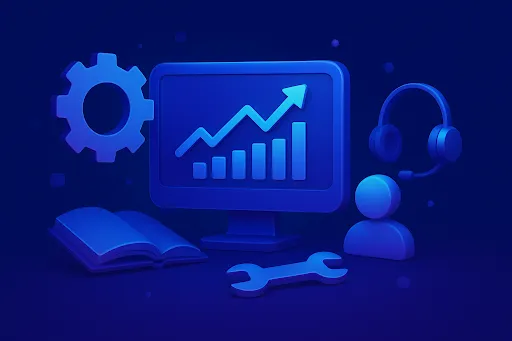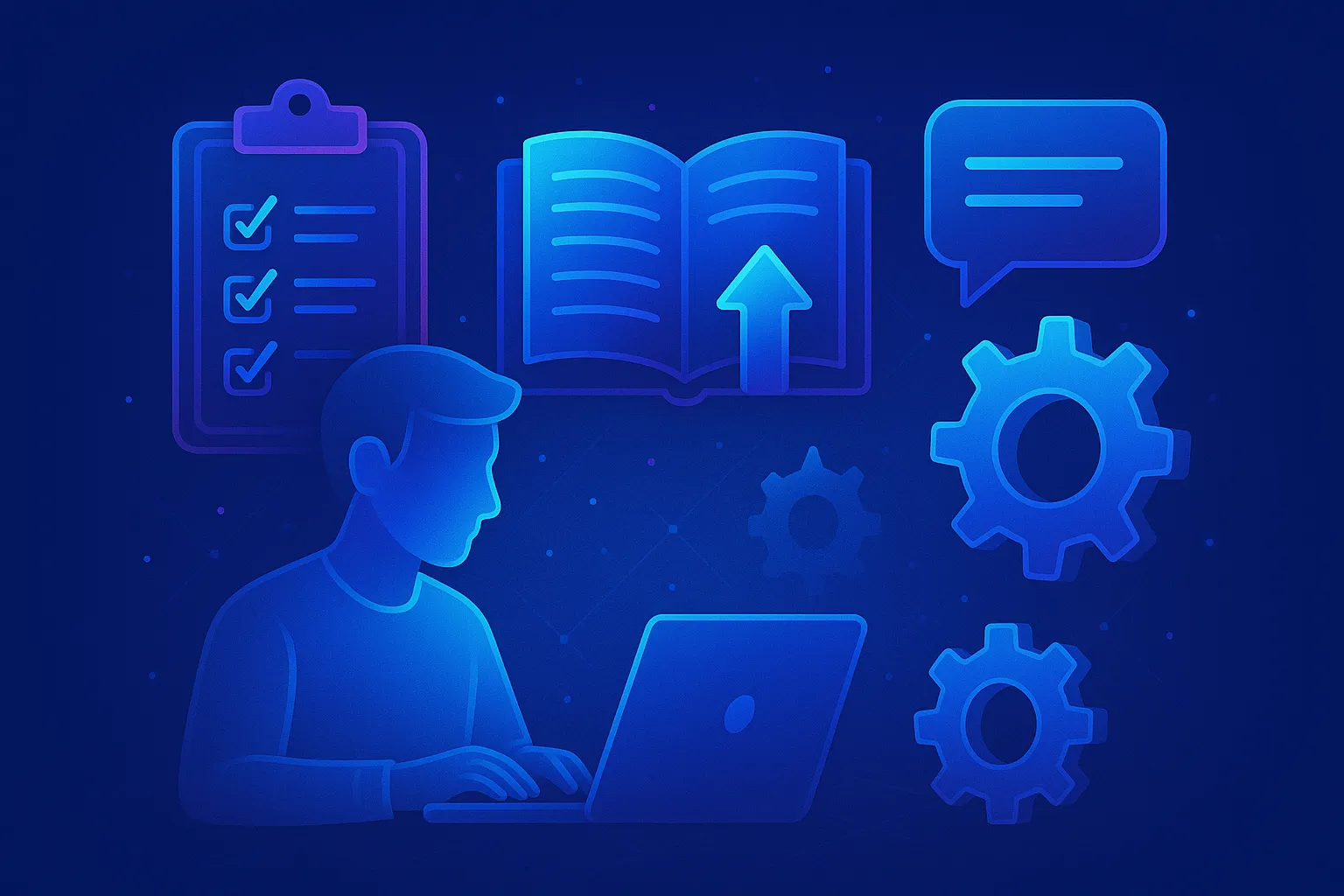October 30, 2025
October 30, 2025

A powerful system alone isn’t enough to drive peak performance. Without proper training and technical support, even the most sophisticated software can leave teams struggling, slowing down workflows and limiting results. Businesses often overlook that human expertise and guidance are just as critical as the technology itself.
When employees are well-trained and backed by responsive technical support, they can navigate systems confidently, avoid costly mistakes, and make processes run smoothly. The synergy between training and support doesn’t just fix problems, it elevates overall system efficiency and maximizes the value of your IT investments. In this article, we’ll uncover how effective training and technical support can transform system performance and why expert solutions from Serdao ensure your team is always empowered to succeed.
A system’s performance is not determined solely by its technical specifications or features; it heavily depends on how effectively users interact with it. Proper training and technical support serve as the backbone of sustained system efficiency, ensuring that both technology and people perform at their best.

1. Proactive vs. Reactive Support
The traditional approach to technical support often focuses on reacting to problems after they occur. While reactive support solves immediate issues, it cannot prevent recurring errors or inefficiencies. In contrast, proactive technical support anticipates potential challenges, identifies bottlenecks early, and implements solutions before they escalate. When combined with ongoing training, proactive support empowers users to operate systems confidently, reducing errors and minimizing downtime.
2. Maintaining System Stability
Even well-implemented systems can face unexpected disruptions, from software glitches to integration issues. Effective technical support ensures that these problems are addressed quickly, maintaining system stability and uninterrupted operations. Users who are trained to recognize and respond to minor issues can prevent them from becoming critical, further enhancing overall performance.
3. Continuous Learning and Adaptation
Systems evolve, and so should the people who use them. Regular training sessions, refresher courses, and updates on best practices keep employees aligned with system improvements. Continuous learning ensures that knowledge gaps do not accumulate over time, and that the workforce remains competent and confident. By integrating training with technical support, organizations create a cycle of improvement where users gain hands-on experience and support simultaneously.
4. Realizing the Full Potential of Your Investment
Investing in advanced systems is only as effective as the human expertise supporting them. Structured training and reliable technical support maximize adoption rates, reduce operational risks, and improve ROI. Organizations that combine these two elements consistently report higher efficiency, smoother workflows, and stronger employee engagement.
For businesses looking to fully harness their system’s capabilities, Serdao’s User Training and Support services provide a comprehensive solution from structured training programs to responsive technical assistance, ensuring teams remain productive, confident, and fully empowered.
While training and technical support are powerful individually, their true potential is unlocked when combined strategically. Organizations that integrate both elements into a cohesive program experience significantly higher system performance, improved user satisfaction, and optimized operational efficiency.
1. Creating a Synergistic Effect
Training equips users with the knowledge and skills needed to navigate systems confidently. Meanwhile, technical support ensures that any obstacles are resolved quickly, preventing frustration and downtime.
When these two components work together, users become more self-sufficient, errors decrease, and productivity rises. The synergy creates a feedback loop: insights gained from support interactions inform future training sessions, continuously enhancing user competency.
2. Accelerating System Adoption
Even the most advanced system fails if users are hesitant or unsure how to use it. Combining training with ongoing technical support accelerates adoption by giving employees the guidance and reassurance they need. This approach reduces resistance to change, helps teams embrace new workflows, and ensures that technological investments deliver maximum value.
3. Reducing Operational Risks
A system can only perform optimally when users are capable and supported. Training alone may leave gaps in practical problem-solving, while support alone may become reactive and inconsistent. Together, they mitigate operational risks: trained users handle routine tasks efficiently, and technical support intervenes promptly when complex issues arise. The result is a stable, reliable system environment where performance is sustained over time.
4. Driving Continuous Improvement
Organizations benefit from a culture of continuous learning and improvement when training and technical support are combined. Data collected from support interactions can identify recurring challenges, which then inform updated training programs. This iterative process strengthens both system performance and user confidence, ensuring that teams are always prepared for evolving technological demands.
Even the most advanced software systems cannot achieve their full potential without properly trained users and reliable technical support. Organizations often invest heavily in technology, yet inefficiencies, user errors, and downtime can prevent them from realizing expected benefits.
Effective training and technical support address these challenges by equipping users with knowledge, providing guidance, and maintaining system stability. Below, we explore how these two factors combine to improve system performance in a sustainable and measurable way.
Proper training equips employees with a deep understanding of system features, workflows, and best practices. When users are confident in navigating the system, they can utilize advanced functionalities that often remain underused. For example, many enterprise applications such as ERP or CRM systems are only partially utilized due to a lack of understanding.
Structured training ensures that employees know how to access and apply these features efficiently, which translates into higher productivity and more accurate execution of tasks. By reducing the knowledge gap, training empowers users to contribute more effectively to organizational goals and fully leverage technological investments.
Human errors are one of the leading causes of system inefficiency and workflow disruptions. Training programs teach users how to avoid common mistakes, follow standardized procedures, and respond to routine issues independently.
At the same time, technical support acts as a safety net, addressing unexpected problems before they escalate into significant downtime or financial loss.
When training and support are combined, organizations can minimize operational bottlenecks, reduce error rates, and ensure smoother daily operations. This synergy creates a more reliable workflow and allows employees to focus on strategic tasks rather than repeatedly correcting mistakes.
Even well-designed systems can face occasional disruptions due to software bugs, integration challenges, or configuration issues. Technical support plays a critical role in maintaining system stability by monitoring performance, troubleshooting problems, and implementing solutions promptly.
Users who have received proper training can often identify minor issues early, preventing them from escalating into larger problems. Together, training and support establish a stable environment where systems operate reliably, downtime is minimized, and overall performance is consistently optimized.
Systems evolve over time, whether through updates, new features, or organizational changes. Continuous training ensures that users remain proficient and adapt quickly to new functionalities.
Technical support complements this by providing ongoing assistance and feedback, which can highlight recurring challenges and inform future training initiatives. This iterative process creates a culture of continuous learning, allowing teams to refine their skills and maintain optimal system performance.
By integrating training and support into a single feedback loop, organizations can foster adaptability, efficiency, and resilience in their operations.
Ultimately, the combination of training and technical support ensures that organizations achieve maximum value from their technology investments. Trained users operate systems more efficiently, make fewer errors, and can adopt new features more quickly, while responsive support minimizes disruptions and resolves issues promptly.
Together, these elements improve productivity, reduce operational costs, and enhance overall performance. By prioritizing both user education and ongoing assistance, organizations create an environment where technology not only works but thrives, delivering measurable benefits for employees and the business as a whole.
Implementing an effective training and technical support strategy is key to ensuring systems perform at their best and employees feel confident in using them. A well-designed approach not only improves productivity but also reduces errors, downtime, and operational frustration.

Here are essential steps to create a strong strategy:
By following these steps, organizations can create a cohesive system where training and support reinforce each other. The result is a workforce that is confident, capable, and equipped to maximize system performance. A strong training and support strategy is not just a short-term fix, it’s an ongoing investment in operational excellence and long-term success.
Conclusion
Technology alone cannot drive exceptional results, its true power lies in the hands of knowledgeable and supported users. By investing in structured training and responsive technical support, organizations empower employees to fully leverage system capabilities, reduce errors, maintain stability, and continuously improve performance. The synergy between these two elements creates a workforce that is confident, capable, and efficient, while ensuring that systems operate at their maximum potential.
Ultimately, a strong training and support strategy is not just a one-time initiative, it is a long-term investment in operational excellence, productivity, and sustainable growth. Organizations that prioritize both user education and technical assistance can unlock measurable improvements in performance, enhance user satisfaction, and realize the full value of their technology investments.